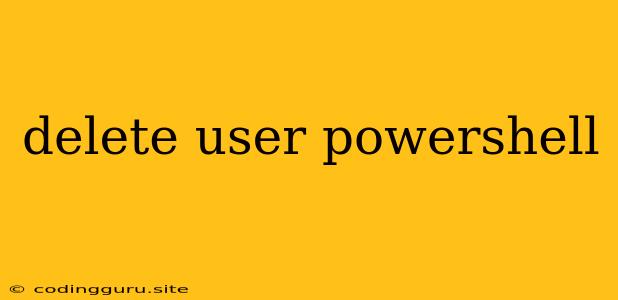Deleting Users in PowerShell
PowerShell is a powerful tool that can be used to automate a wide range of tasks, including managing users on your system. Deleting users with PowerShell is a quick and efficient way to remove unwanted accounts. But before you go deleting, make sure you understand the process and its potential consequences.
Understanding User Deletion in PowerShell
Deleting a user in PowerShell doesn't just remove the account from the system. It also deletes any associated data, including:
- Profile: The user's profile folder, which contains their settings, documents, and other files.
- Home Directory: The user's home directory, which is the location where their files and data are stored.
- Group memberships: The user's membership in any groups on the system.
- Login history: Any logs of the user's login activities.
Important Note: Deleting a user is a permanent action. You cannot undo this process. It's crucial to back up any critical data before proceeding with deletion.
How to Delete a User in PowerShell
Here's a step-by-step guide to deleting a user in PowerShell:
- Open PowerShell as Administrator: Right-click the PowerShell icon and choose "Run as administrator."
- Locate the User: To identify the user you want to delete, you can use the
Get-ADUsercmdlet. For instance, to find a user named "John Doe", use the following command:Get-ADUser -Identity "John Doe" - Confirm User Identity: The output will display details about the user. Double-check that you have the correct user account.
- Delete the User: Once you've confirmed the user, use the
Remove-ADUsercmdlet to delete the account. Replace"John Doe"with the actual username.
Note: TheRemove-ADUser -Identity "John Doe" -Confirm:$false-Confirm:$falseparameter suppresses the confirmation prompt, allowing for automated scripts.
Deleting Users in PowerShell with Specific Parameters
PowerShell offers additional parameters to fine-tune user deletion:
-Recursive: This parameter deletes the user's home directory, profile, and any associated data. This is often used for complete removal.-WhatIf: This parameter simulates the deletion process without actually deleting the user. Use this to verify the command's effect before committing.-Force: This parameter forces the deletion without prompting for confirmation. Use this with caution as it bypasses any safety checks.
Example:
Remove-ADUser -Identity "John Doe" -Recursive -WhatIf
This command would simulate the deletion of "John Doe" with the -Recursive option.
Best Practices for User Deletion
- Verify User Information: Always confirm the user's identity before deleting.
- Back up Data: Create backups of essential data before deleting users to avoid data loss.
- Check for Dependencies: Ensure that the user is not linked to critical systems or processes before deletion.
- Use
-WhatIf: Test the deletion command with-WhatIfto verify its effect without permanent changes. - Document Actions: Record the details of any user deletion actions, including the date, time, and user involved.
Conclusion
PowerShell provides a streamlined way to manage users, including deletion. By following the steps and best practices outlined above, you can safely and efficiently delete users from your system. Remember to prioritize data protection and carefully consider the consequences of each deletion action.
